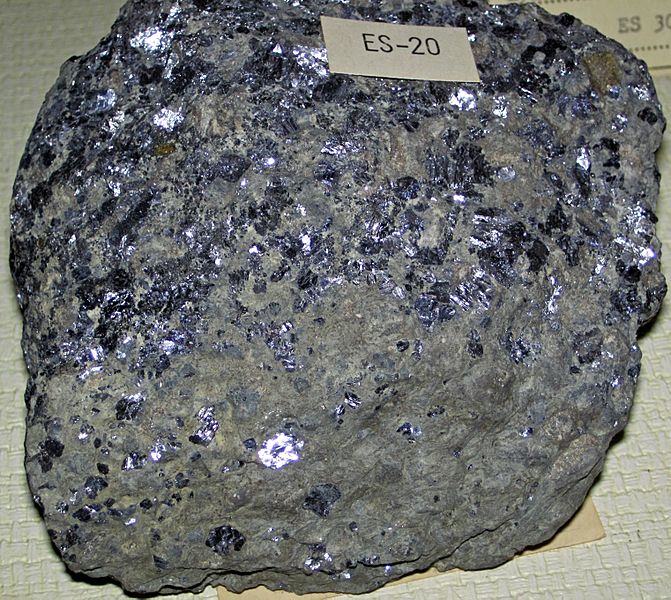Image: Galena in dolostone (Bonneterre Dolomite, Upper Cambrian; Flat Rock, Old Lead Belt, Missouri, USA) 2 (40704497164)

Description: Galena in dolostone from the Cambrian of MIssouri, USA. (public display, Geology Department, Wittenberg University, Springfield, Ohio, USA) Silvery-gray = galena Dark gray = dolostone A mineral is a naturally-occurring, solid, inorganic, crystalline substance having a fairly definite chemical composition and having fairly definite physical properties. At its simplest, a mineral is a naturally-occurring solid chemical. Currently, there are over 5200 named and described minerals - about 200 of them are common and about 20 of them are very common. Mineral classification is based on anion chemistry. Major categories of minerals are: elements, sulfides, oxides, halides, carbonates, sulfates, phosphates, and silicates. The sulfide minerals contain one or more sulfide anions (S-2). The sulfides are usually considered together with the arsenide minerals, the sulfarsenide minerals, and the telluride minerals. Many sulfides are economically significant, as they occur commonly in ores. The metals that combine with S-2 are mainly Fe, Cu, Ni, Ag, etc. Most sulfides have a metallic luster, are moderately soft, and are noticeably heavy for their size. These minerals will not form in the presence of free oxygen. Under an oxygen-rich atmosphere, sulfide minerals tend to chemically weather to various oxide and hydroxide minerals. Galena is a lead sulfide mineral (PbS). It has a metallic luster, silvery-gray color, cubic crystals, cubic cleavage, is moderately soft, and has a very high specific gravity (it's very heavy for its size). Galena is the most important lead ore mineral. It's principally found in hydrothermal vein systems and in Mississippi Valley-type deposits. Silver (Ag) can fall into the lead position as an impurity, sometimes in relatively high proportions. This results in argentiferous galena, (Pb,Ag)S. Historically, lead from galena has been used as a gasoline additive, a paint ingredient, and for making bullets. Lead is also used to make various metal products, batteries, and radiation shielding. The rock shown here consists of galena partly replacing dolostone (Bonneterre Dolomite, Upper Cambrian). It comes from a Mississippi Valley-type deposit in Missouri. Commonly abbreviated "MVT", Mississippi Valley-type deposits are named for a series of mineral deposits that occur in non-deformed platform sedimentary rocks along the Upper Mississippi River Valley, USA. Many specific minerals occur in MVT deposits, but are dominated by galena, sphalerite, barite, and fluorite. These minerals occur in caves and karst, paleokarst structures, in collapse fabrics, in pull-apart structures, etc. MVT deposits in America are mined as important, large sources of lead ore and zinc ore. The classic areas for MVT deposits are southern Illinois, the tristate area of Oklahoma-Missouri-Kansas, northern Kentucky, southwestern Wisconsin, and southeastern Missouri. The minerals are hydrothermal in origin and were precipitated from basinal brines that were flushed out to the edges of large sedimentary basins (e.g., the Illinois Basin and the Black Warrior Basin). In basin edge areas, the brines came into contact with Mississippian-aged carbonate rocks (limestone and dolostone), which caused mineralization. The brines were 15% to 25% salinity with temperatures of 50 to 200 degrees Celsius (commonly 100 to 150 degrees C). MVT mineralization usually occurs in limestone and dolostone but can also be hosted in shales, siltstones, sandstones, and conglomerates. Gangue minerals include pyrite, marcasite, calcite, aragonite, dolomite, siderite, and quartz. Up to 40 or 50 pulses of brine fluids are recorded in banding of mineral suites in MVT deposits (for example, sphalerite coatings in veins have a stratigraphy - each layer represents a pulse event). Each pulse of water was probably expelled rapidly - overpressurization and friction likely caused the water to heat up. Some bitumen (crystallized organic matter) can occur, which is an indication of the basinal origin of the brines. The presence of asphalt-bitumen indicates some hydrocarbon migration occurred. Some petroleum inclusions are found within fluorite crystals and petroleum scum occurs on fluorite crystals. MVT deposits are associated with oil fields and the temperature of mineral precipitation matches the petroleum window. The brines may simply have accompanied hydrocarbon fluids as they migrated updip. The high temperatures of these basin periphery deposits wasn't necessarily influenced by igneous hydrothermal activity. Hot fluids can occur in basins that are deep enough for the geothermal gradient to be ~100 to 150 degrees Celsius. If a permeable conduit horizon is present in a succession of interbedded siliciclastic sedimentary rocks, migration of hot, deep basinal brines may be quick enough to get MVT deposit conditions at basin margins. MVT deposits occur in the Upper Mississippi Valley of America as well as in northern Africa, Scandinavia, northwestern Canada, at scattered sites in Europe, and at some sites in the American Cordillera. Some of these occurrences are in deformed host rocks. MVT deposits have little to no precious metals - maybe a little copper (Cu). Mineralization is usually associated with limestone or dolostone in fracture fillings and vugs. Little host rock alteration has occurred - usually only dolomitization of limestones. The age of the host rocks in the Mississippi Valley area varies - it ranges from Cambrian to Mississippian. Dating of mineralization has been difficult, but published ages indicate a near-latest Paleozoic to Mesozoic timing. MVT deposits in the Upper Mississippi River area are often divided into three subtypes based on the dominant mineral: 1) lead-rich (galena dominated); 2) zinc-rich (sphalerite dominated); and 3) fluorite-rich. Stratigraphy: Bonneterre Dolomite, Upper Cambrian Locality: unrecorded/undisclosed site at or near Flat Rock, Old Lead Belt, Missouri, USA Photo gallery of galena: <a href="http://www.mindat.org/gallery.php?min=1641" rel="nofollow">www.mindat.org/gallery.php?min=1641</a>
Title: Galena in dolostone (Bonneterre Dolomite, Upper Cambrian; Flat Rock, Old Lead Belt, Missouri, USA) 2 (40704497164)
Credit: Galena in dolostone (Bonneterre Dolomite, Upper Cambrian; Flat Rock, Old Lead Belt, Missouri, USA) 2
Author: James St. John
Usage Terms: Creative Commons Attribution 2.0
License: CC BY 2.0
License Link: https://creativecommons.org/licenses/by/2.0
Attribution Required?: Yes
Image usage
The following page links to this image:

